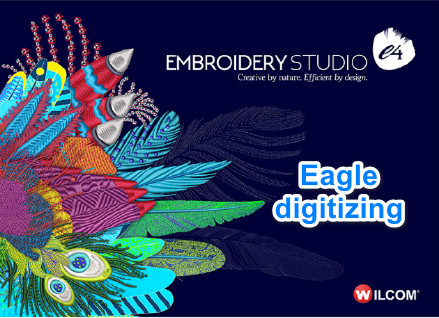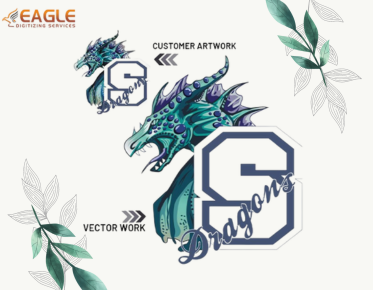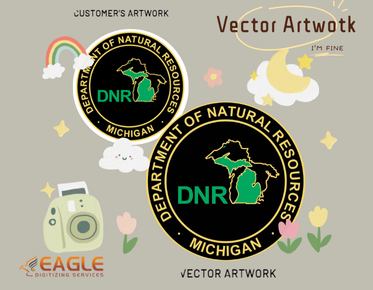Easier Embroidery Software: Wilcom or Hatch?
Embroidery digitizing software is crucial for turning creative ideas into embroidered reality. The right software can make the process smooth and enjoyable, while the wrong one can be a source of endless frustration. Today, we delve into the ease of use of two leading embroidery digitizing software: Wilcom and Hatch. Both offer robust features, but how do they fare when it comes to user-friendliness?
Why Ease of Use Matters in Embroidery Digitizing
Ease of use is paramount in embroidery digitizing because it directly affects productivity and creativity. User-friendly software reduces the learning curve, allowing designers to focus on creativity rather than technical hurdles. It also minimizes errors and streamlines the workflow, making the digitizing process more enjoyable and efficient.
Overview of Wilcom and Hatch
A Brief History of Wilcom
Wilcom has been a pioneer in the embroidery industry since 1979. Known for its advanced features and professional-grade capabilities, Wilcom has set high standards in embroidery digitizing. It has consistently evolved, integrating cutting-edge technology to meet the demands of modern embroiderers.
The Evolution of Hatch
Hatch, developed by the creators of Wilcom, is a more recent addition to embroidery software market. Launched to cater to a broader audience, including hobbyists and small businesses, Hatch combines powerful features with a user-friendly interface. It aims to bring professional-grade embroidery capabilities to users of all skill levels.
Getting Started: Installation and Setup
Installing Wilcom: Step-by-Step
Installing Wilcom is straightforward but requires attention to detail. Begin by downloading the installation file from the official Wilcom website. Follow the on-screen instructions to complete the installation. Ensure your computer meets the software's system requirements to avoid performance issues.
Setting Up Hatch: A Beginner's Guide
Setting up Hatch is designed to be user-friendly. Aft er purchasing or downloading the software, the installation wizard guides you through each step. The process is intuitive, ensuring even those with limited technical knowledge can get started without hassle.
User Interface and Navigation
First Impressions: Wilcom’s Interface
Wilcom’s interface is comprehensive, featuring a multitude of tools and options. While it might seem overwhelming at first, the layout is logically organized, allowing users to find essential functions quickly. The interface caters to advanced users who need access to a wide range of features.
Navigating Hatch: User-Friendly or Not?
Hatch’s interface is designed with simplicity in mi n find their way around without much difficulty.
Learning Curve: How Quick Can You Learn?
Wilcom: Time to Master the Basics
Wilcom, with its extensive features, has a steeper learning curve. However, once you get the hang of the basics, the software becomes a powerful tool in your arsenal. Online tutorials and comprehensive manuals can help shorten the learning period.
Hatch: Getting Up to Speed
Hatch is designed to be accessible, with a shorter learning curve compared to Wilcom. Most users can grasp the basics relatively quickly, thanks to its user-friendly interface and abundant learning resources.
Design Creation and Editing
Creating Designs in Wilcom: Ease and Efficiency
Creating designs in Wilcom is a blend of art and precision. The software offers advanced tools that allow for intricate detailing and creative freedom. While it might take some time to master these tools, the end results are often worth the effort.
Editing Designs with Hatch: Simplicity and Speed
Hatch excels in design editing with its straightforward tools. Users can easily modify designs, adjust stitches, and experiment with different effects. The software’s simplicity doesn’t compromise the quality of edits, making it a favorite among many embroiderers.
Built-in Tools and Features
Exploring Wilcom’s Toolset
Wilcom boasts a rich toolset, from basic editing tools to advanced digitizing features. It includes everything from stitch editing and lettering to auto-digitizing and vector conversion. These tools offer immense creative control but require some expertise to use effectively.
Hatch’s Features: What’s in the Box?
Hatch offers a robust set of features tailored for both beginners and advanced users. It includes auto-digitizing, design editing, and lettering tools, all accessible through a user-friendly interface. Hatch’s features are designed to enhance creativity without overwhelming the user.
Customization and Flexibility
Customizing Your Workflow in Wilcom
Wilcom provides extensive customization options, allowing users to tailor their workflow to their specific needs. From setting up personalized toolbars to creating custom stitch types, Wilcom ensures that users can work in a way that suits them best.
Hatch: Personalization Options
Hatch also offers customization options, though they are slightly more streamlined compared to Wilcom. Users can modify toolbars, set preferences, and create custom templates, making the software adaptable to various embroidery styles and techniques.
Help and Support
Wilcom’s Support System: Is It Helpful?
Wilcom offers robust support, including detailed manuals, online tutorials, and a dedicated customer service team. Users can also access a community forum where they can share tips and seek advice from other embroiderers.
Getting Help with Hatch: Resources and Community
Hatch provides extensive support through online resources, including video tutorials, webinars, and a vibrant user community. The support system is designed to help users at all skill levels, ensuring they can make the most of the software.
Tutorials and Learning Resources
Learning Wilcom: Best Tutorials and Guides
Wilcom offers a wealth of learning resources, from official tutorials to third-party guides. These resources cover everything from basic operations to advanced techniques, helping users master the software at their own pace.
Hatch Learning Resources: Where to Start
Hatch’s learning resources are abundant and accessible. The official website offers step-by-step tutorials, while numerous online communities provide additional tips and tricks. These resources make it easy for users to get started and advance their skills.
File Compatibility and Export Options
Wilcom: Supported File Formats
Wilcom supports a wide range of file formats, making it compatible with various embroidery machines and software. This flexibility ensures that users can work with different design files without compatibility issues.
Hatch: Exporting Your Designs
Hatch also supports numerous file formats, allowing for easy export and integration with different embroidery machines. The software simplifies the export process, ensuring that designs can be transferred seamlessly.
Performance and Speed
How Fast is Wilcom? Real-world Performance
Wilcom is known for its robust performance, handling complex designs with ease. The software runs smoothly on well-configured systems, though performance may vary based on the computer’s specifications.
Hatch: Speed and Efficiency in Use
Hatch is optimized for speed and efficiency, ensuring quick processing times even for detailed designs. The software’s performance is reliable, making it a practical choice for both hobbyists and professionals.
Compatibility with Embroidery Machines
Using Wilcom with Various Machines
Wilcom’s extensive compatibility with different embroidery machines makes it a versatile choice. Users can easily connect and transfer designs, ensuring smooth operation across various equipment.
Hatch: Machine Compatibility and Integration
Hatch offers seamless integration with a wide range of embroidery machines. This compatibility ensures that users can effortlessly transfer designs and achieve consistent results across different devices.
Cost and Value for Money
Wilcom Pricing: What You Get for Your Money
Wilcom’s pricing reflects its professional-grade features and extensive capabilities. While it is an investment, the software’s comprehensive toolset and robust performance offer significant value for serious embroiderers.
Hatch: Is It Worth the Price?
Hatch offers a more affordable option without compromising on quality. Its pricing is designed to be accessible to a wider audience, making it a valuable choice for both beginners and experienced users.
User Reviews and Feedback
What Users Love About Wilcom
Users appreciate Wilcom’s powerful features, extensive customization options, and reliable performance. However, some find the learning curve steep and the price high, which can be a consideration for new users.
Hatch User Reviews: Pros and Cons
Hatch is praised for its user-friendly interface, comprehensive features, and excellent support. Some users note that while it’s not as feature-rich as Wilcom, it offers a balanced mix of simplicity and capability, making it a popular choice for many.
Common Issues and Troubleshooting
Frequent Problems with Wilcom and Solutions
Common issues with Wilcom include installation difficulties and occasional software bugs. However, these can typically be resolved through the support resources and updates provided by Wilcom.
Troubleshooting Hatch: Common Fixes
Hatch users may encounter problems like compatibility issues or interface glitches. Fortunately, the extensive support resources and active user community provide effective solutions and troubleshooting tips.
Comparing Advanced Features
Wilcom: Advanced Tools and Capabilities
Wilcom excels in advanced features, offering tools for intricate designs, custom stitch creation, and detailed editing. These capabilities make it a preferred choice for professional embroiderers seeking precision and control.
Hatch: What Advanced Users Need to Know
While Hatch is designed to be user-friendly, it doesn’t skimp on advanced features. It includes powerful tools for design creation and editing, though it may not offer the same level of depth as Wilcom for extremely detailed work.
Ease of Use for Beginners
Wilcom: Is It Beginner-Friendly?
Wilcom, with its extensive features, can be overwhelming for beginners. However, with the right resources and patience, new users can learn to navigate and utilize the software effectively.
Hatch: A Good Choice for Newbies?
Hatch is particularly well-suited for beginners, thanks to its intuitive interface and abundant learning resources. It provides a gentle introduction to embroidery digitizing without sacrificing functionality.
Professional Use: Meeting Industry Standards
Wilcom for Professional Embroiderers
Wilcom is the gold standard for professional embroiderers, offering the precision and advanced features needed to meet industry standards. Its comprehensive toolset ensures that professionals can create high-quality, detailed designs.
Hatch in a Professional Setting
Hatch also holds its own in a professional setting, providing the necessary tools and features to produce professional-grade designs. Its user-friendly nature makes it a practical choice for small businesses and individual professionals.
When comparing Wilcom and Hatch, both have their strengths and weaknesses. Wilcom offers advanced features and customization options, making it ideal for professionals. Eagle Digitizing provides embroidery digitizing services. Hatch, on the other hand, provides a user-friendly interface and accessible pricing, making it suitable for beginners and hobbyists.
Ultimately, the choice between Wilcom and Hatch depends on your specific needs and experience level. For those seeking professional-grade features and willing to invest the time to learn, Wilcom is an excellent choice. For users looking for a balance of functionality and ease of use, Hatch offers a compelling option. Choose the software that best aligns with your embroidery goals and enjoy the creative journey. Eagle Digitizing is here to support your embroidery digitizing needs.



